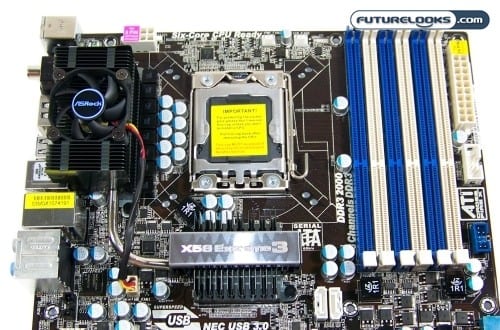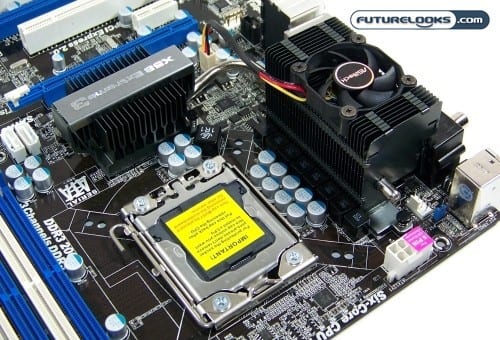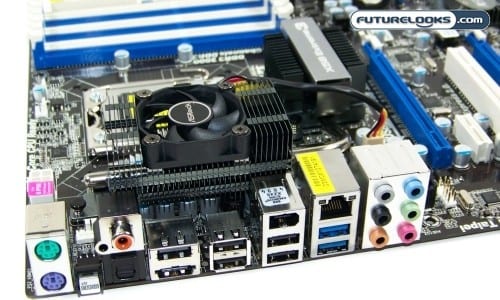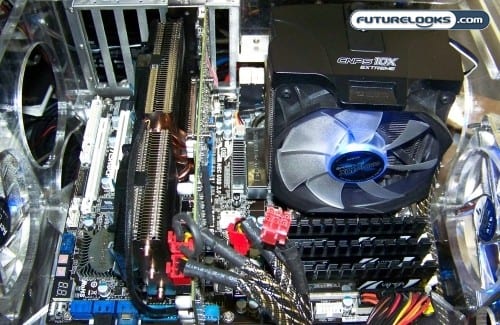Cool as a Cucumber

The ASRock X58 Extreme 3 makes some concession to budget conscious users with high end coolers that fit previous generation LGA775 sockets. The Combo Cooler Option (C.C.O.) design allows support for both LGA775 and LGA1366 aftermarket CPU coolers. If you happen to have a Noctua NH-U12D from a couple years ago, you won’t need to order any special adapter kits or extra parts to make it fit this board. That’s a very significant savings.
Despite the novelty of this feature, users should also keep in mind that the LGA775 retail cooler itself is not recommended for any Core i7 900 series processor. If you have something newer like a Core i5-750, you’ll be fine with that particular retail cooler though Intel would like it if you stick with the cooler that come with specific sockets. Given the low price of so many aftermarket coolers, do yourself a favor and err on the side of caution if you’re sporting an old stocker.

The last cooling feature we want to comment on is the use of a 60mm mini-fan to cool the PWM heat sink which is in turn cooling the V8 Phase PWM circuits underneath. Typically, standard operations don’t drive these circuit temps that far up. Perhaps engineers see this more as a precaution given that the board supports some overclocking.
Buttons, Extras, and IO Ports

We’re happy to see ASRock continuing use of some good quality parts to assemble this motherboard. Some rather nice power and reset buttons can be found at the bottom right of the PCB near the front IO panel connections. There is also a matching CMOS CLR (BIOS Clear) button in the IO back. This will save you from having to open the case up to clear the BIOS if you happen to push your overclock just a little too far. If ASRock can get this right, why can’t everyone else?
Lastly, the rear IO panel offers your usual expansion and connectivity options. among the USB, Optical, LAN, Firewire, and PS/2 ports.
Test System Configuration

Since the X58 Extreme 3 supports 980X out of the box, we of course have to try that out. If it can handle Intel’s pride and joy desktop power house processor, it’ll handle any Quad or Dual core with ease. As for installation, I would compare it to the experiences of the ASUS, GIGABYTE, or MSI platforms: Uneventful and without hassle. This is usually a really good indication of what to expect during testing. We tend to be a bit unforgiving when a platform doesn’t install as it should. But, we’re giving the Extreme 3 here a big two thumbs up for just working out of the box.
Our test system setup is as follows:
- Processor: Intel Core i7-980X Gulftown
- CPU Cooled By: Zalman CNPS10X Extreme
- Motherboard 1: ASRock X58 Extreme 3 LGA1366 Motherboard
- Motherboard 2: GIGABYTE GA-X58A-UD5 LGA1366 Motherboard
- Memory: ViperII 6GB 2000MHz DDR3 Triple Channel Memory Kit
- Graphics Card: ZOTAC Geforce GTX480 Video Card
- Storage/SSD: Kingston SSDNow V+ 128GB SSD
- Power Supply: Antec TPQ-1000 Watt
- Test Enclosure: DangerDen Torture Rack
Just to be clear, the BIOS was updated, CPU cooler cleaned out, video card cleaned out as well, and I got a handy laser temp gun ready to check out some thermals during testing, where applicable. We also ensured that all drivers and BIOS were updated to the latest as of the publishing of this review and Windows 7 Ultimate 64 bit was our operating system of choice. Now let’s get into our benchmarks shall we?
